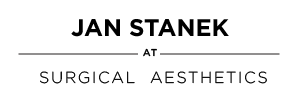Chin Augmentation Surgery by Jan Stanek at Surgical Aesthetics
Facial plastic surgery makes it possible to enhance your appearance and eliminate features that undermine self-confidence. A well-defined chin helps to give balance to the face and creates a major part of one's profile. When people look in the mirror, most focus on the size and shape of their noses, their ears, sagging jowls, or fine wrinkling of the skin. But even though few examine their chins, having a “weak chin” is certainly not an asset. Surgeons who specialize in rhinoplasty, or surgery of the nose, are often the first to suggest that changes in chin size or shape may enhance a profile as much as rhinoplasty. Chin augmentation is often necessary to achieve facial balance and harmony.
Fortunately, this is a relatively straightforward procedure and it can make a major difference. Inserting an implant or moving the bone forward to build up a receding chin, or by reducing a jutting or too prominent chin can achieve a pleasing, balanced profile. When there is a contributing problem of dental malocclusions or birth defects in the structure of the jaw itself, surgery of the jaw can improve the form and function of the lower face and greatly enhance appearance.
Your consultation can help you decide on the type of surgery that addresses your concerns. Your surgeon can also provide information on new medical techniques for chin surgery and offer recommendations for supplementary surgery that can ensure the greatest improvement. As with all elective surgery, good health and realistic expectations are prerequisites. It is also key to understand all aspects of the surgery.
Chin Augmentation: The Operation
To augment the chin, the surgeon begins by making an incision either in the natural crease line just under the chin or inside the mouth, where gum and lower lip meet. By gently stretching this tissue, the surgeon creates a space where an implant can be inserted. This implant, made of synthetic material that feels much like natural tissue normally found in the chin, is available in a wide variety of sizes and shapes. This allows custom fitting of the implant to the configurations of the patient's face. After implantation, the surgeon uses fine sutures to close the incision. When the incision is inside the mouth, no scarring is visible. If the incision is under the chin, the scar is usually imperceptible.
In chin reduction surgery, incisions are made either in the mouth or under the chin. The surgeon sculpts the bone to a more pleasing size. The procedure, depending on the extent of the work, takes about an hour and is done under a general anaesthetic.
Chin Augmentation: The Operation
Immediately after surgery, the surgeon usually applies a dressing that will remain in place for two to three days. Usually, the chin is taped to minimize swelling and discomfort. Sutures in the skin will be removed in five to seven days. If an intra-oral incision is used, the sutures will dissolve. You will experience some numbness, tenderness, swelling and bruising. Post-operative discomfort can be controlled with prescribed medications. Chewing will probably be limited immediately after chin surgery, and a liquid and soft food diet may be required for a few days. Most patients feel a stretched, tight sensation after the surgery, but this usually subsides in a week. It's normal to experience some temporary difficulty with smiling and talking. If there is numbness you must avoid drinking hot or cold drinks.
Mouth hygiene is important. Avoid to brush your lower teeth and use a gargle frequently.
After approximately six weeks, most swelling will be gone, and you can enjoy the results of your procedure. Normal activity can be resumed after approximately ten days.
Chin Augmentation: Possible Complications
Problems rarely occur, but you need to be informed about such possibilities. Bleeding and infection can occur with any operation. If infection were to occur around a facial implant and did not clear up after treatment with antibiotics, the implant might have to be temporarily removed and replaced at a later time. A chin implant can shift slightly out of alignment and a second operation may be necessary to replace it in its proper position. Some of the implant materials are made of a solid silicone. Currently, there is no scientific evidence that this is a harmful substance.
When you discuss your surgery with your plastic surgeon, be certain that you clearly express your expectations. He/she will help you determine what it is possible to achieve. Remember, with any facial surgery, you may feel and look better in a short period of time. However, it may not be advisable to participate in certain activities -- especially activity that may result in the face being jarred or bumped -- for several weeks. You may not be able to accurately evaluate your appearance for weeks, or perhaps even months. Give yourself plenty of time to get used to your new look.
You may be surprised to find that most people won't recognize that you've had chin implant surgery -only that you look better!
Find out more
For more information about chin augmentation surgery, or to book a consultation with Jan Stanek at Surgical Aesthetics in London, please enquire below.





